IMEHA (International Model Equine Hobbyists Association) was an online photo showing site that existing until 2018. Included on the site were these guidebooks for judging and showing model horses in Performance classes. MEPSA has obtained permission to share the info contained in the guides.
Point Deducts :: Set-Up Options :: Photo Examples
IMEHA offers 15 classes in the Sidesaddle Division:
- Sidesaddle Western Pleasure
- Sidesaddle Western Equitation
- Sidesaddle Western Arena Trail
- Sidesaddle Western Games (Pole Bending, Barrels, Gymkhana Games)
- Sidesaddle Western Other (Stock Work Events, Western Riding, Reining, etc.)
- Sidesaddle Huntseat Pleasure
- Sidesaddle Formal Huntseat Events (Hunter Over Fences, Hunter Hack, or Handy Hunter, Fox Hunting, Show Hack)
- Sidesaddle Dressage
- Sidesaddle English Huntseat Attired Other Events (Jumper, Cross Country, English Games, English Riding, etc.)
- Sidesaddle English Equitation – Huntseat or Saddleseat
- Sidesaddle English Arena Trail – Huntseat or Saddleseat
- Sidesaddle Saddleseat (5-Gaited, 3-Gaited, Pleasure, Park)
- Sidesaddle Saddleseat Other (English Riding, English Games)
- Sidesaddle Costume or Historical
- Sidesaddle Other (Parade, Endurance, Trail Rides, etc.)
No cross entering between sidesaddle classes.
Sidesaddle Has Four Different Styles of Tack and Attire
Sidesaddle is broken up into four different divisions. Huntseat, Saddleseat, Western and Historical Sidesaddle.
Sidesaddle entries regardless of the tack used should display perfect manners. Any horse which appears to be shying, spooking, above the bridle, overly excited, going crooked, or otherwise misbehaving should be strongly penalized. Note: Arabian sidesaddle classes are far more lenient in requirements for appointments, correct attire as outlined under the Modern section or fully-researched historical attire should be given preference, as directed by IAHA Judging Schools.
Modern Sidesaddle
The general rule is that a lady may ride sidesaddle in any class in which she is otherwise eligible to compete. Although some divisions restrict the sidesaddle, enough open classes are available to make any breed or type of horse or pony acceptable. Tack and equipment are strongly traditional, even in open shows, a knowledgeable judge may penalize small errors in appointments.
Classes offered using Huntseat Sidesaddle Tack:
Sidesaddle Huntseat Pleasure – (Hunter Under Saddle)
Entries into this class must display required Huntseat tack and appointments, including Double or Pelham bridle, Top Hat with Veil, and whip. Numnahs and saddle cloth not permitted.
Sidesaddle Formal Huntseat Events
Only one photo per horse allowed – So choose your best.
Sidesaddle Hunter Over Fences, Hunter Hack, or Handy Hunter: Must use required Huntseat tack and appointments, including Double or Pelham bridle. Veils are not required. Hunting breastplates and whips are optional. Leg wraps or boots, Numnahs and saddle cloths are not permitted. Martingales are optional for Hunter Over Fences or Handy Hunter, but not permitted for Hunter Hack.
Sidesaddle Fox Hunting: May use Double, Pelham or Snaffle bridle. Veils are not required. Hunting breastplates and whips are optional. Leg wraps or boots are prohibited.
Sidesaddle Show Hack: May use Double, Pelham or Snaffle bridle. Day coat with huntcap or Shadbelly with Top Hat optional. Veils are not required. Hunting breastplates and whips are optional. Leg wraps or boots are prohibited.
For additional information see English Working Events.
Sidesaddle Dressage
Entries should use Dressage arena and tests and follow Dressage rules for bridles and attire (such as snaffle bridles and huntseat attire for lower level tests, double bridles and formal, shadbelly attire for upper level tests). Veils are not required. Whips no longer than 47.2 inches are optional.
Sidesaddle English Equitation – Huntseat or Saddleseat
(Requires a doll rider) The class is judged 80% on the rider and 20% on the horse. Horses are asked to walk, trot, canter and sometimes hand gallop both directions of the arena, to stand in a line-up, rein-back and for a possible pattern consisting of other movements at the direction of the judge. Open to both hunt seat and saddleseat tack and attire. May use Double, Pelham or Snaffle bridle. Veils are not required. Hunting breastplates and whips are optional.
Sidesaddle English Arena Trail – Huntseat or Saddleseat
Entries into this class must display required tack and appointments, including Double or Pelham bridle, Top Hat with Veil, and whip. Open to both hunt seat and saddleseat tack and attire. May use Double, Pelham or Snaffle bridle. Numnahs and saddle cloth not permitted.
Sidesaddle English Huntseat Attired Other
Only one photo per horse allowed – So choose your best.
May be any English hunt seat activity using hunt seat sidesaddle tack and attire and following the rules for the specific English event, for example: Jumper, Cross Country, English Games, English Riding, etc.
Huntseat Ridden Sidesaddle Appointments and Attire
Plain English type sidesaddle, may have suede seat and pommels; or two pommels. Girths should be leather, not shaped. A breastplate is optional but preferred. Hunt attire also requires a combined sandwich case/flask which is carried on the offside of the saddle. A full double bridle is strongly preferred, although a pelham is permissible (A Double or Pelham bridle is required for Hunter events, however a snaffle bit is frequently seen in the ring in other than the hunter division.) All leather must be flat and a cavesson noseband is required. Braided mane and tail required. Off-side saddles (with rider’s legs on the horse’s right side) do still exist, although they are rare. All requirements are otherwise the same.
Fit of the saddle; The near side of the saddle extends farther forward than the right side, with the safe (the near-side skirt) allowing for the rider’s right leg to rest on the horse’s left shoulder while the off-side skirt is approximately in the normal saddle position. Girth should be in the normal position.
Forbidden tack are martingales (except in over fence classes) any boots or bandages. In an appointments class, saddle pad, elastic girth and stirrup pad are not permitted.
Attire
Habit should be black or dark blue. Coat is similar to a regular hunt coat, but features a cut-away at the front to allow a smooth line over the rider’s thigh. The coat should just reach the saddle. The apron should be smooth, without drape, the hem should be horizontal and parallel to the ground. A hunt top hat is most correct, a derby is sometimes seen is pleasure classes, and a huntcap is permitted is over fence classes. With a top hat, rider should wear a veil in appointment classes. Breeches are of same color as habit. Vest should be white, buff or yellow. Boots black, no tops. Gloves are required. A light hunt whip with thong is required in appointments class. Rider’s hair must be confirmed in a net, preferably a bun. One spur is optional; no spur on the right foot!
Classes offered using Sidesaddle Saddleseat Tack:
Sidesaddle Saddleseat 5-Gaited, 3-Gaited, Pleasure, Park
Entries into this class must display required tack and appointments for Saddleseat events (5-Gaited, 3-Gaited, Pleasure, Park) including Double or Pelham bridle. Numnahs and saddle cloth not permitted. Follows the rules for Saddleseat.
Sidesaddle Saddleseat Other
Events for this classes would be: SS English Riding, SS English Games. Only one photo per horse allowed – So choose your best. Follows the rules for Saddleseat.
Sidesaddle English Equitation – Huntseat or Saddleseat
(Requires a doll rider) The class is judged 80% on the rider and 20% on the horse. Horses are asked to walk, trot, canter and sometimes hand gallop both directions of the arena, to stand in a line-up, rein-back and for a possible pattern consisting of other movements at the direction of the judge. Open to both hunt seat and saddleseat tack and attire. May use Double, Pelham or Snaffle bridle. Veils are not required. Hunting breastplates and whips are optional. Saddleseat type entries follow the rules for Saddleseat.
Sidesaddle English Arena Trail – Huntseat or Saddleseat
Entries into this class must display required tack and appointments. Open to both hunt seat and saddleseat tack and attire. May use Double, Pelham or Snaffle bridle. Veil not required. Numnahs and saddle cloth not permitted.
Saddleseat Ridden Sidesaddle Appointments and Attire
Saddle matches requirements for saddleseat. Bridle should be accurate for the breed, type and class depicted. Saddle pads are not prohibited but not preferred and should be unnoticeable as possible if used. Colored girths as in cross-saddle classes for the same breed or type are appropriate.
Attire
Habit should be a color appropriate for the breed, type or class but more conservative colors are preferred. The coat is similar to a regular saddle seat coat in cut and length but may have a cutaway in the front skirts to allow a smooth line over the rider’s right thigh. The coat length may reflect the current style. The apron should be smooth, without drape or gores; the hem should be horizontal and parallel to the ground. A derby or top hat as appropriate for the saddleseat style of riding. The rider should wear hunt-style breeches (color matching the apron under the apron.) and hunt boots beneath the apron (regular saddle seat boots are uncomfortable and can be dangerous in sidesaddle saddleseat) Vests, gloves, etc. are appropriate for the breed, type and class. A whip is optional, but virtually essential; it should be carried in the right hand and be the same type as used in the equivalent cross-saddle classes.
Classes offered using Western Sidesaddle Tack:
Sidesaddle Western Pleasure
Follows the rules for Western Pleasure.
Sidesaddle Western Equitation
The rider will be judged 80% for posture, cueing and steering. The horse will be judged 20% on manners and performance of the horse. All horses are to enter the ring at a walk, whether they enter as individuals or as a class. A judge will designate whether they will use individual patterns or rail work. At some shows the classes will begin with individual pattern work. If a Western Equitation pattern is depicted, please indicate the source and the step and movement depicted. Any work on the rail should include a flat-footed, fourbeat walk, a two-beat jog, and a three-beat lope displaying the correct lead. Reversing, if called for, should be done away from the rail. Contestants are expected to stay on the rail at all times and to use the corners of the arena as they are intended when rail work is called for. Western Sidesaddle Equitation riders should sit square in the saddle, spine to be perpendicular to a horse’s backbone. Shoulders to be square and back. Head straight and level. The left leg should hang straight down naturally and close to the horse’s side. The heel should be down and the stirrup resting on the ball of the foot, exactly as an astride rider. The left knee rests against the saddle. The lower portion of the rein arm should be parallel with the ground and the reining hand over the right knee. The upper rein arm will take about a 30 degree angle. The knuckles of the reining hand should be vertical with the ground and the reining hand should always be held directly over the right knee and in no way forward of this knee. The upper portion of the inactive arm should be vertical with the body and the elbow of this arm should not protrude to the rear of the upper body. When using closed reins, the inactive hand should be closed around the free ends of the reins and the lower portion of this arm held at about a 45 degree angle in a natural position.
Sidesaddle Western Arena Trail
Follows the rules for Western Arena Trail.
Sidesaddle Western Games
Only one photo per horse allowed – So choose your best.
Follows the rules for Western Games.
Sidesaddle Western Other
Only one photo per horse allowed – So choose your best.
May be any Western activity using Western Sidesaddle tack and attire and following the rules for the specific western event, for example: Stock Work events, Western Riding, Reining, etc.
Western Ridden Sidesaddle Appointments and Attire
A western sidesaddle is preferred; it will have skirts, a cantle roll, and generally resemble a modern western saddle. Some exhibitors attach a stirrup fender to a standard English sidesaddle, or may use an older Victorian style sidesaddle. A modern Western sidesaddle will have two pommels, often plus a vetigial pommel on the offside of the seat, other models may have only a single pommel. The bit and the bridle as appropriate for the breed, type and class. Rein and romal strongly referred, even in the breeds where split reins dominate. Some divisions allow western riders to carry a whip or a crop in the right hands. Although this is legal, it is not preferred, as it is not attractive and elegant as a sidesaddle turnout should be. A rein and romal is strongly preferred in all western sidesaddle turnouts.
Attire
Shirt, vest, trousers, boots, hat, etc., identical to requirements for the breed/type/class cross-saddle rider. Apron must be a closed or button type with belt under loops. The top of the apron should be cut similarly to chaps and be double thickness. Many western aprons are made of chap leather, but seldom of suede. They may have decorative yokes as seen on chaps, conchos, and or fringe down the back edge. N.E.A. Sidesaddle Assoc. says the hem may be ankle length or 2″- 4″ above the ankle. The apron should be smooth, without drape or extra material and must hang level and completely cover the right foot. ASA or ISSO have no ruling online. Arabians appear to use a longer drape with the decorated back edge and or fringe extending downward to a pointed drape longer than the front and similar to the way chaps are cut.
Costume or Historical Ridden Sidesaddle Appointments and Attire
Sidesaddle Costume or Historical
Only one photo per horse allowed – So choose your best.
Ladies have ridden in various forms of sidesaddle for centuries. The original sidesaddle was a kind of armchair mounted sideways across a horse’s back. Ladies did not turn to face the front until the time of Catherine de Medici. Equipment and attire varied widely; any historical sidesaddle entry should be supported by documentation. Note that many queens and other noble ladies had formal horseback portraits painted; often the clothing in these portraits is no more appropriate for riding than a formal court dress would be today. An entry depicting this sort of documentable Historical scene might well to be supported by a comment line depicting the source. Historical Sidesaddle type entries might depict, for example, The Era of Full Skirts (17th century to 1875), The Era of Shaped Skirts (1875-1915), or the early years of the Era of Sidesaddle Aprons. The entry may be in an historical setting and does not have to be in an arena competition.
For Costume Ridden Sidesaddle type entries the rider may be dressed in any creative costume (such as Christmas) or the costume of a specific nationality (such as Spanish).
Other Sidesaddle Appointments and Attire
Sidesaddle Other Class
Only one photo per horse allowed – So choose your best.
Entries into this class may include (but not limited to) Sidesaddle events which do not fit elsewhere such as: Endurance, Trail Rides, Parade etc.
UK – SSA Rules
Adult lady Rider:
Habit: with bowler (derby), “restrained hue” (black, navy, brown, grey, rarely dark green or maroon), long boots (black with black bowler, brown with brown bowler), garter straps optional. Blunt spur or spur band on left boot. Apron to finish approx. one hand width above spur strap, right foot not to show. Hem of apron to be parallel to ground. Jacket hem to finish above back of horse, preferably clear or back of saddle. Breeches to match habit. Plain or discreetly striped shirt with collar and tie, waistcoat in yellow or maroon.
Hair to be worn in small bun (or false bun). Veil to match bowler, fastened at back above or on bun. No jewelry. Brown or tan leather or string gloves, NEVER black. Whip or cane not to exceed one meter.
Safety hat also permitted, in which case no veil is worn.
Safety hat required for Riding Club Open Side-saddle, Working Hunter Horse/Pony, Side-saddle Equitation Jumping and Show Jumping classes>p> With silk hat (traditionally only correct for afternoon classes at County and above level, but may be worn in any SSA affiliated classes except where safety hat required): dark (black, navy) habit: long black boots: plain hunting tie or stock with collarless shirt; dark brown, tan or chamois leather gloves: hair, waistcoat and jewelry as above: ladies’ silk hat (NOT dressage topper).
Junior Female Rider:
Turnout as for adult bowler but with safety hat: jodhpur boots for younger children: hair must be tidy and any ribbons plain blue, black or brown. Whip not to exceed 76cm on ponies under 14.2h. Spur/spur band not compulsory.
Gentlemen:
Traditional Ratcatcher – ie, tweed jacket, shirt/tie, yellow or Tattersall check waistcoat, long boots with garter straps, blunt spurs, plus bowler or safety hat. (NB: ‘Ratcatcher” is not a garment but a style of dress in the UK/Ireland)
Junior male:
As above, with safety hat, joddy boots for younger riders, whip and hair as Junior Female.
TACK
British hunting side-saddle, linen or serge lined (or Wykeham pad) with safety stirrup fitting/stirrup. Threefold leather or brown lampwick girth with central strap for full-length balance girth (where fitted). Balance girth – full length or sewn to girth – is optional. Discreet numnahs permitted.
Bridle with plain brownband/noseband. Double bridle or pelham required with silk hat: snaffle bridle permitted with bowler (flash or cavesson nosebands only on snaffle bridles). Plain, plaited or laced leather reins, must not catch on right foot.
NOT permitted: martingales, boots bandages. (Sandwich cases, gloves etc. as per US rules NEVER seen in show ring)
Cruppers permitted on ponies, but must be correctly fitted.
HORSE/PONY Mane/tail must be plaited, except for breeds whose standard calls for a natural m/t.
Resources
USFA Rulebook
NEASA Rulebook
Links for Historical Sidesaddle ideas:
Sidesaddle Blog
Historical Sidesaddle
NEASA
Extra Credit Should Be Given If:
(1) Rein contact is steady but gentle at all times. It is referred to as ‘direct contact’ On a model entry this can be achieved by using sticky wax and makes the rein go in a direct straight line from the bit to the rider’s hand with no slack in the rein.
(2) Bight (Excess rein) of rein is draped on the right.
(3) Entry Number is shown on saddle blanket or on rider’s back.
Points Should Be Deducted If:
(1) Model is on the wrong lead.
(2) Model appears to display a slowness in any gait or loss of forward momentum resulting in an animated and/or artificial gait at the lope.
(3) Rider touches horse or saddle with free hand.
(4) Model’s head is carried too high.
(5) Model’s head carried too low tip of ear below the withers.
(6) Model is overflexed or has a strained neck in head carriage so the nose is carried behind the vertical.
(7) Model displays excessive nosing out.
(8) Model displays an opening mouth excessively.
(9) Rider uses spurs forward of the cinch.
(10) Model appears sullen, dull, lethargic, emaciated, drawn or overly tired.
(11) Model appears agitated has ears back, tail twirled, etc.
(12) Model displays quick, choppy or pony strides.
(13) Reins are draped and not a direct contact.
Set-Up Options:
Outdoor Fencing May Be Used in Field Classes: Outdoor Arena but not required
Outdoor Field but not required
Arena Fencing Required in Arena Classes: Indoor or Outdoor Arena
Types of Fencing Allowed:
- Painted or Natural
- Post and Rail
- Post and Plank
- Chain Link
- Solid Plyboard
- Plyboard with Top Rail
- Post with Drape Rope
- Stock Tube Pipe Rail
- Interior Arena Wall
Footing Required:
- Dirt
- Sand
- No rock base
Examples of Sidesaddle:
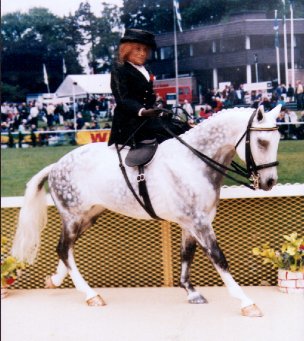
Sidesaddle Formal Huntseat – Show Hack
DA Ruby Cairo, warmblood mare. Horse, tack and doll made by Karon Grieve and owned by Karon Grieve.
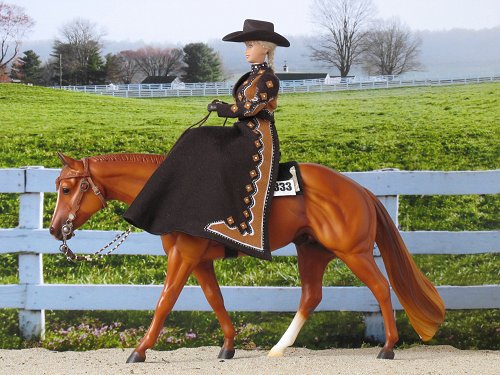
Sidesaddle Western Pleasure
Easy on the Attitude, shown as Chestnut Quarter Horse Gelding is a Breyer Zippo Pine Bar. Owned by Andrea Robbins. Caption: Entrant jogs along the rail as instructed by the Western Sidesaddle Pleasure judge.
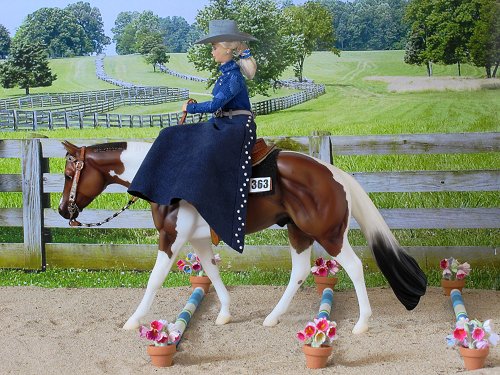
Sidesaddle Western Arena Trail
Ruggedly Handsome Hawk , shown as bay tobiano Paint stallion is a Breyer Rugged Painted Lark. Owned by Andrea Robbins. Caption: Entrant is jogging through the trot-over poles in the Side Saddle Western Arena Trail class.

Sidesaddle Dressage
Apparition is a Dappled gray Hanoverian mare, CM Breyer Show jumper by Donahue. Owned by Andrea Robbins. Caption: USEF EVENTING: DRESSAGE TEST: INTEREMEDIATE TEST B: STEP 19. E Half circle left 10 meters. (at a canter). ENTRY DEPICTS: At E, beginning a half circle canter on left lead.
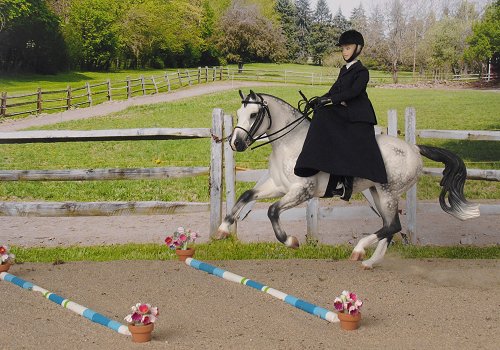
Sidesaddle English Arena Trail
Huntseat or Saddleseat
Apparition is a Dappled gray Hanoverian mare, CM Breyer Show jumper by Donahue. Owned by Andrea Robbins. Caption: Entering the lope-over poles in a Sidesaddle English Arena Trail event.
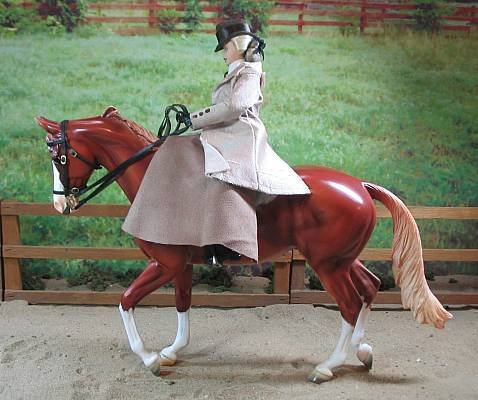
Sidesaddle English Arena Trail
Huntseat or Saddleseat
Alec, shown as Chestnut TB Stallion is a Peter Stone Thoroughbred, owned by Dianne Teachworth. Caption: Sidesaddle Saddleseat at a trot on the rail.

Sidesaddle Formal Huntseat
Hunter Over Fences
Apparition is a Dappled gray Hanoverian mare, CM Breyer Show jumper by Donahue. Owned by Andrea Robbins. Caption: While on the course, horse and rider canter past one of the fences in the Sidesaddle Hunter Over Fences class.
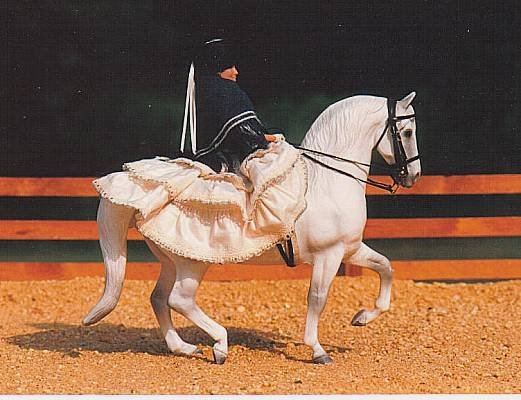
Sidesaddle Costume
Pluto Primavera, shown as a Gray Lippizan Gelding is a Breyer Pluto, owned by Dianne Teachworth. Caption: Sidesaddle Spanish Costume.
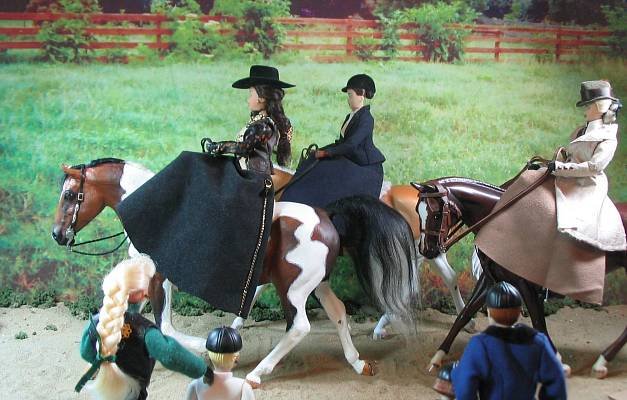
Sidesaddle Other
Parade
Tardis’ Promise, shown as a Bay tobiano Am WB Mare is a Custom Breyer Morganglanz by Marie J.S. Phillips. Owned by Dianne Teachworth. Caption: Parade for sidesaddle riders in both English and Western tack and outfits.
Doll Rider Correct Seat and Hold the Reins Correctly:
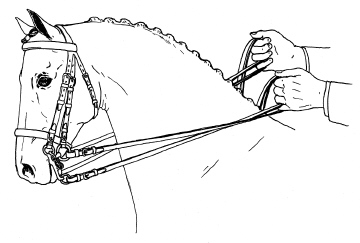
Double Bridle Reins – 2 and 2 Method. Most common handle hold in model horse hobby. It is advised that you put in your comment line what hold your set up is so that judge’s know you understand the three styles on holding the reins.

Double Bridle Reins – 3 in 1 Method. A true challenge for model horse hobbyists and doll rider’s with razor cut slips in the fingers of the hands. Left side curb goes directly back to hand and enters under ring finger with the left snaffle rein coming directly back and entering under the pinky finger with rein crossing over the curb rein. Right side curb rein goes directly back and enters under the middle finger of the left hand with all three reins coming up thru hand and out over the of the index finger with bight cascading down the right side. The right side snaffle goes directly and enters the hand under the ring finger, up into the hand and out over the top of the index finger with the bight draping down the right side. The look gives an ‘X’ to reins the left side of horse’s neck but a two independent rein look to the right side but only one rein going into the right hand. Very tricky set up.
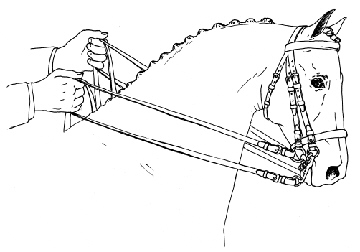
Double Bridle Reins – Fillis Method. The Fillis method of holding the reins is when the curb reins enter the rider’s hand from the bottom, around the little fingers and up to the second joint of the index fingers while the snaffle enters the fist from above over the index fingers. Each hand holds two reins.
